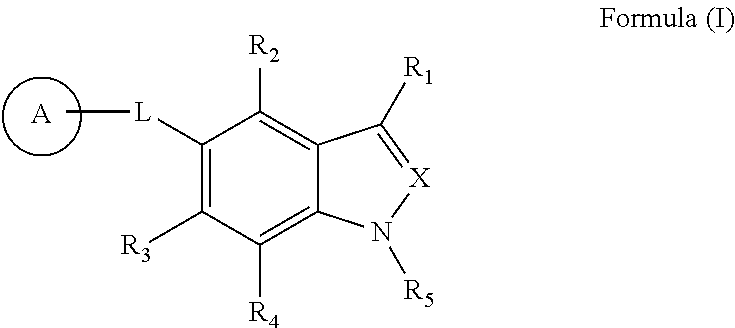Indole and indazole compounds that activate ampk
- Summary
- Abstract
- Description
- Claims
- Application Information
AI Technical Summary
Benefits of technology
Problems solved by technology
Method used
Image
Examples
example 1
Step 1
methyl 5-bromo-6-chloro-1H-indole-3-carboxylate
[0701]To a stirred mixture of 5-bromo-6-chloro-1H-indole (60 g, 260 mmol), N,N-dimethylaminopyridine (3.21 g, 26.0 mmol), pyridine (56.5 mL, 703 mmol), and tetrahydrofuran (400 mL) was added in drops at 0° C. neat trichloroacetyl chloride (70.1 mL, 625 mmol). The obtained mixture was warmed to room temperature in 2 h (a precipitate began to form) and was stirred at room temperature for 3 days. Added in drops 110 ml of methanol at 0-10° C. followed by 70 ml of 25% sodium methoxide in methanol (680 mmol) at 0° C. The mixture was then stirred at 45° C. for 3 h. Then 250 ml of water and 200 ml of MTBE were added. The organic extract was separated, washed with brine, dried over magnesium sulfate, and concentrated at 50° C. and 90 mm Hg to ˜¼ of the initial volume. Precipitate was filtered off, washed with MTBE, and dried in vacuum at 45° C. to obtain the title compound (39.9 g, 53% yield). The mother liquor was concentrated to a heavy ...
example 2
6-Chloro-5-[4-(hydroxymethyl)phenyl]-1H-indole-3-carboxylic acid
[0704]
Step 1
6-Chloro-5-(4-hydroxymethyl-phenyl)-1H-indole-3-carbaldehyde
[0705]A mixture of 5-bromo-6-chloro-1H-indole-3-carbaldehyde (783 mg, 3.03 mmol), 4-(hydroxymethyl)benzene boronic acid (460 mg, 3.03 mmol), 2 N aqueous potassium carbonate (6.4 mL, 13 mmol) in toluene (9 mL) and EtOH (13 mL) was degassed with N2 for 5 minutes, then treated with [1,1′-bis(diphenylphosphino)ferrocene]dichloropalladium(II) (247 mg, 0.30 mmol). The mixture was heated in a sealed tube to 120° C. and stirred for 2.5 hours. The reaction mixture was cooled to room temperature, diluted with EtOAc (200 mL), then washed with water (50 mL) and brine (50 mL). The organic layer was dried over MgSO4 and concentrated in vacuo. The resulting brown foam was purified by flash chromatography (20-100% EtOAc / heptane) to afford a pale yellow solid. The solid was dissolved in 5:1 EtOAc / heptane (30 mL), and a colorless precipitate formed. The precipitate w...
example 3
6-Chloro-5-phenyl-1H-indole-3-carboxylic acid
[0707]
Step 1
6-Chloro-5-phenyl-1H-indole-3-carbaldehyde
[0708]A mixture of 5-bromo-6-chloro-1H-indole-3-carbaldehyde (200 mg, 0.77 mmol), phenyl boronic acid (114 mg, 0.93 mmol), 2 N aqueous potassium carbonate (1.15 mL, 3.10 mmol) in toluene (3.3 mL) and EtOH (1.1 mL) was degassed with N2, treated with [1,1′-bis(diphenylphosphino)ferrocene]dichloropalladium(II) (56.6 mg, 0.077 mmol), and degassed again with N2. The mixture was subjected to microwave irradiation conditions at 120° C. for 30 minutes. The reaction mixture was cooled to room temperature, diluted with water and extracted with EtOAc (50 mL). The organic layer was washed with brine, dried over MgSO4 and concentrated in vacuo. The crude material was purified by flash chromatography (0-46% EtOAc / petroleum ether) to afford the title compound (190 mg, 98% yield) as a yellow solid.
[0709]MS (ES+) 255.9 (M+H)+. 1H NMR (400 MHz, CD3OD) δ 9.91 (s, 1H), 8.18 (s, 1H), 8.13 (s, 1H), 7.63 (s,...
PUM
 Login to View More
Login to View More Abstract
Description
Claims
Application Information
 Login to View More
Login to View More - R&D
- Intellectual Property
- Life Sciences
- Materials
- Tech Scout
- Unparalleled Data Quality
- Higher Quality Content
- 60% Fewer Hallucinations
Browse by: Latest US Patents, China's latest patents, Technical Efficacy Thesaurus, Application Domain, Technology Topic, Popular Technical Reports.
© 2025 PatSnap. All rights reserved.Legal|Privacy policy|Modern Slavery Act Transparency Statement|Sitemap|About US| Contact US: help@patsnap.com



